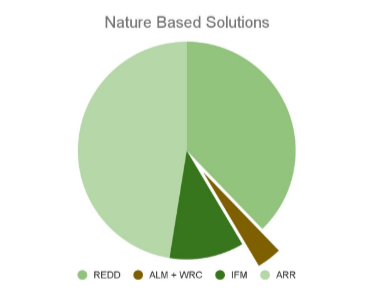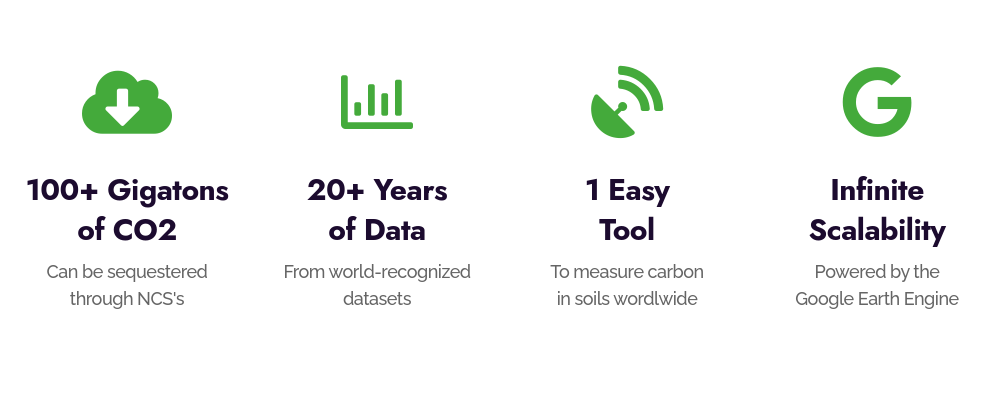Seqana uses remote sensing technology to conduct soil carbon sequestration analysis.
Carbon storage has become a prevalent issue. With our world's reliance on carbon emitting activities, the safe removal and storage of it is an important consideration. Carbon sequestration is the capture, removal and storage of carbon dioxide from the atmosphere. This can be done by both nature-based and emerging technology solutions. Many of the nature-based solutions are called carbon sinks, because they absorb more carbon from the atmosphere than they release.
While many folks immediately think of trees when it comes to nature-based carbon sequestration, other natural items also sequester carbon. These include things like seaweed, bamboo, the ocean, and the soil. Soil actually sequesters 4x more carbon than trees, however less than 5% of the world’s available soil carbon is utilized for this purpose1. Soil holds the largest portion of available carbon on earth, and many don’t realize just how much of a difference that can be made using the carbon under their feet.

Tracking carbon emissions is a necessary way to understand the effect of human interactions with the environment. Current technology innovations now track carbon emissions as well as the absorption of carbon. While it’s a relatively new concept, tracking carbon storage is extremely necessary as it allows us to understand the ‘net amount’ of carbon that is emitted (emissions - storage = net emissions) or the amount of carbon offsets that are naturally available. These offsets come into play in the Voluntary Carbon Markets, where these carbon sinks are sold as offsets against carbon emissions.
The process for developing and selling carbon credits in the carbon markets is somewhat complex. It starts with Carbon Project Developers who manage projects that are developed to sequester, manage, or destroy emissions. These organizations come in many forms including private companies, non-profits, and NGOs. The project developers use the funds from the carbon credit sales to continue investing into the projects and provide planetary benefits. And they need to be held accountable to achieve the results that they’ve promised. This is where monitoring, reporting, and verification (MRV) plays an important role in the carbon markets. Unfortunately, traditional MRV technology is slow and extremely expensive for project developers. The process can take months or even years to complete which can limit the growth of these environmental projects and hamper the overall voluntary carbon markets .
Seqana is a global carbon sequestration monitoring system focused on soil organic carbon. The platform compiles data from a variety of sources, including satellite imagery, and uses statistical modeling to produce analytics. The company produces insights that allow project developers and other stakeholders to measure and monitor soil organic carbon levels via software rather than from the field. Utilizing Seqana’s technology platform, users avoid traditional soil sampling and measuring procedures which saves both time and money. To date, Seqana’s technology has been used to analyze over 1.2 billion hectares.

In addition to Monitoring Services, Seqana also offers scouting tools to help project developers find the best sites for their projects. The company will also be launching Seqana.Earth, a brand new software that will allow users to track, report, and even sell their carbon storage from their own homes. Powered by the Google Earth engine, it is a tool that will allow project developers to use this data for monitoring, reporting, and verification insights. With the tool, users are able to access global vegetation data from the past 20 years.
Seqana’s goal is to simplify the MRV process for soil organic carbon projects and make these projects more accessible. Through analytics, they believe they can help the industry scale regenerative agriculture practices and increase the amount of carbon that is absorbed from the atmosphere. Seqana’s technology is projected to help over 500 million farmers.
To learn more about Seqana, watch the company’s presentation at our Understory Showcase here: Understory’s ‘Startups Driving Sustainability’ January 2022 Showcase Event.
You can also check out the The Understory Podcast episode featuring the CEO and Co-Founder of Seqana: Stefan Gönner of Seqana: sequestering soil organic carbon.
[1] Seqana. 2022








Join the conversation.